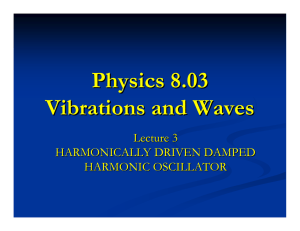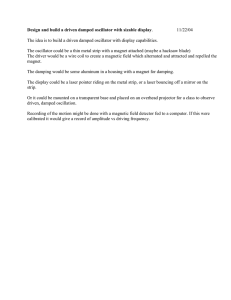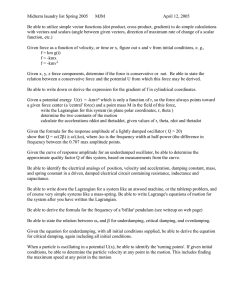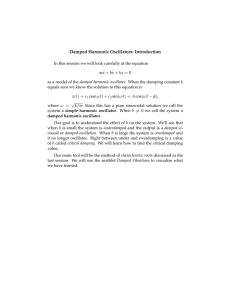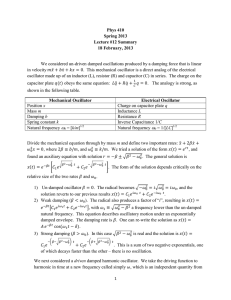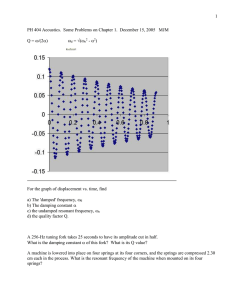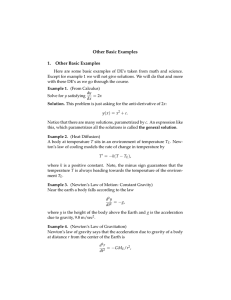Damped and Driven Harmonic Motion Physics 1425 Lecture 29 Michael Fowler, UVa
advertisement
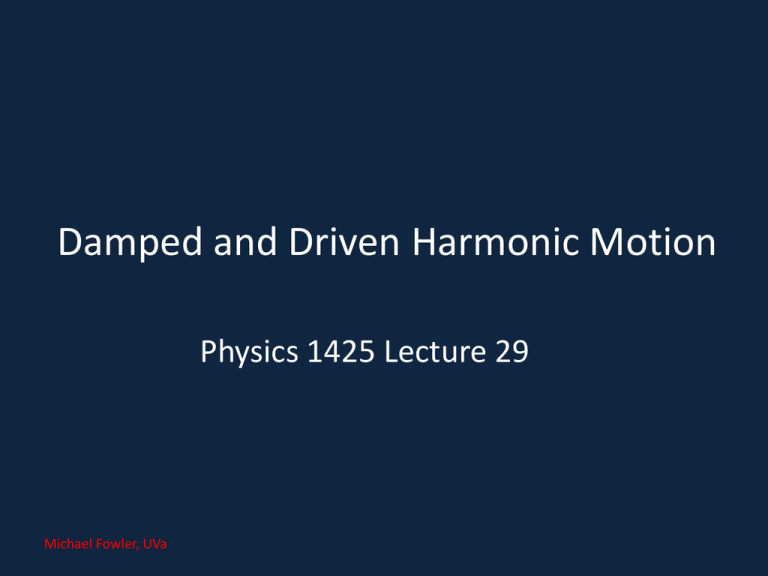
Damped and Driven Harmonic Motion Physics 1425 Lecture 29 Michael Fowler, UVa Damped Harmonic Motion • In the real world, oscillators • C Spring’s force Drag force experience damping forces: F = − kx F = −bv friction, air resistance, etc. m • These forces always oppose the motion: as an example, Extension x we consider a force F = −bv The direction of drag force proportional to velocity. shown is on the assumption that the mass is moving to the left. • Then F = ma becomes: ma = −kx −bv 2 2 0 • That is, md x / dt + bdx / dt + kx = Underdamped Motion • The equation of motion md 2 x / dt 2 + bdx / dt + kx = 0 has solution x = Ae −γ t cos ω ′t where γ = b / 2m, = ω′ ( k / m ) − ( b 2 / 4m 2 ) Plot: m = 1, k = 4, b = 0.11 Underdamped Motion • The point to note here is that the damping can cause rapid decay of the oscillations without a perceptible change in the period (around 0.04% for b = 0.11, k = 4, m = 1). Underdamped Motion • Compare the curve with • a the equation: the successive position maxima follow an exponential curve Ae −γ t , so any maximum reached is, say, 90% of the previous maximum. • Remember the energy at maximum displacement is ½kx2. x = Ae −γ t cos ω ′t Clicker Question • The amplitude in a damped oscillator reaches half its original value after four cycles. At which point does the oscillator have only half its original energy? A. 2 cycles B. 4 cycles C. 8 cycles Not So Underdamped Motion Even when the damping absorbs 98% of the energy in one period, the change in the length of the period is only around 10%! • a Critical Damping • As the damping is further increased, the period lengthens until at b2 = 4mk it becomes infinite, and the amplitude decays exponentially. • (Actually, in this one case a prefactor A + Bt is needed to match initial conditions—we’ll ignore this minor refinement.) Overdamping • Doubling the damping beyond critical damping just doubles the time for the amplitude to decay by a given amount. Ideal Damping for Shock Absorbers? • Critical damping is not the best choice: underdamping gives a quicker response, and the overshoot can be very small. • Explore this for yourself: download the spreadsheet! The Damped Driven Oscillator • We now consider a damped oscillator with an external harmonic driving force. • We’ll look at the case where the oscillator is well underdamped, and so will oscillate naturally at ω0 = k / m . • The external driving force is in general at a different frequency, the equation of motion is: md x / dt + bdx / dt + kx = F0 cos ωt 2 2 The Damped Driven Oscillator • If the driving frequency is far from the natural frequency, there is only a small response, even with no damping. Here the driving frequency is about twice the natural frequency. The Damped Driven Oscillator • This shows the oscillator with the same strength of external driving force, but at its natural frequency. • The amplitude increases until damping energy losses equal external power input: this is resonance. • Spreadsheet link! • Tacoma Narrows Bridge.


